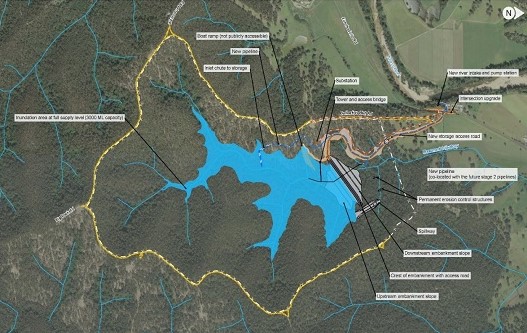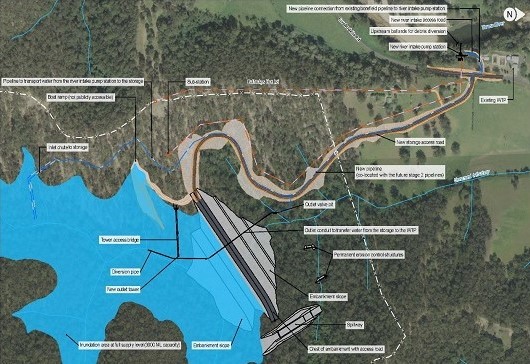Southern Water Supply Storage
Project: Provision of a second water storage facility for Eurobodalla in the southern part of the shire
Timeframe: 2016 to 2025
Status: In progress
Cost and funding: $150 Million comprising:
- Australian Government $51.2 million
- NSW Government $25.6 million
- Council will fund the remainder
Page last updated: March 2025
Details
We are working to:
- construct a 3,000 megalitre off-river water storage dam next to the Tuross River, predominantly in Bodalla State Forest.
Benefits to the community:
- a new pump station will transfer water from the Tuross River into the storage dam during times of high flows.
- supplement the existing water supply during periods of drought and high demand.
- improve the security of water supply in the Eurobodalla Shire and reduce the need for water restrictions in the future.
Water will be pumped from the river in accordance with the Water Sharing Plan for the Tuross River Unregulated and Alluvial Water Sources 2016 (Tuross River WSP). The Tuross River WSP sets a maximum amount of water that can be extracted depending on the river flow at the time. Selectively drawing water from the river will minimise pressure on the river system.
Key features of the off-stream storage facility include:
- capacity to hold up to 3,000ML of water
- a 370m long embankment, 39m in height and a crest width of 20m, located on an unnamed tributary of the Tuross River
- a spillway to allow the dam to release water from heavy rainfall events into the Tuross River
- permanent erosion control structures located downstream of the spillway
- an inlet to convey and dissipate raw water transferred from the river intake pump station through a pipeline
- an outlet to allow transfer of water from the storage to the existing water treatment plant (WTP)
- instruments to monitor seepage, reservoir levels and water quality
- a thermal stratification control system
- a boat ramp at the water storage facility for maintenance and access for water quality monitoring
- safety and perimeter fencing at the water storage facility.
Key features of the ancillary facilities include:
- a new pump station with capacity to extract up to 26ML from the river and up to 6ML from the borefield
- water transfer infrastructure with:
- a pipeline with a capacity of 26ML per day to transfer raw water from the new river intake pump station to the storage inlet chute
- a pipeline connection from the borefield to the river intake pump station
- a storage access road roughly 1km long from Eurobodalla Road opposite the WTP to the site
- a 70m long access road for vehicles to access the river intake pump station
- power supply including new sub-stations near the storage and pump station.
- Click to view a larger image over the proposal overview
- Click to view a larger image of the proposal overview with key infrastructure
Key features of the proposal are shown in the image below.
Consultants prepared an Environmental Impact Statement (EIS) to support the State Significant Development application to the NSW Department of Planning and Environment. The EIS was placed on public exhibition in September 2018 and is available via the NSW Planning Portal:
- potential environmental impacts
- safeguards and management measures to mitigate these impacts.
You can read the outcomes of these assessments in the EIS. The specialist assessments included:
- water resources, hydrology and potential changes to water flow
- biodiversity (terrestrial and aquatic ecology)
- socio-economic impacts, including land use and property
- Aboriginal heritage
- non-Aboriginal heritage
- traffic and transport
- noise and vibration
- bushfire planning and management
- greenhouse gases and climate change
- air quality
- landscape and visual impacts.
- threatened species, populations or ecological communities or their habitats
- matters of national environmental significance or on the environment of Commonwealth land.
In 2016, we reviewed our Integrated Water Cycle Management Strategy, taking into account revised forecasts in water demand and the Tuross River WSP. This review confirmed the need for the construction of the water storage facility.
Project approval for the Eurobodalla Southern Water Supply Storage was obtained in 2019 under Part 4, Division 4.7 (State Significant Development) (formerly Division 4.1) of the Environmental Planning and Assessment Act 1979 (EP&A Act).
A biodiversity offset strategy was prepared in 2021 to provide guidance for the delivery of biodiversity offsets for the impacts expected as a result of the proposed facility and to achieve long-term conservation gain for the threatened species, populations and communities impacted by the Project.
The following construction and environmental management plans were prepared in relation to the project:
- Tuross River Intake Pump Station site clearing (6.5 MB)
- Tuross River Intake Pump Station construction (9.8 MB)
- Access road construction (16.8 MB)
- Storage site clearing (19.3 MB)
- Storage construction (12.9 MB)
Other compliance documents required for the project include:
- Storage construction environmental monitoring data (1.1 MB)
- Pollution Incident Response Management Plan (1.3 MB)
- Independent Audit 1 (3.6 MB)
- Independent Audit 2 (5.2 MB)
- Independent Audit 3 (4.7 MB)
- Response to Independent Audit 1 recommendations (226.4 KB)
- Response to Independent Audit 2 recommendations (279.1 KB)
- Response to Independent Audit 3 recommendations (274.6 KB)
Updates
2025
- In January we completed the spillway and continued work to finish the other supporting structures. We are continuing to import clay to finish the dam embankment.
2024
- By the end of the year we had nearly completed all supporting structures for the dam such as the outlet tower, spillway, inlet pipe, and outlet valve house and pipework. Work on the dam embankment reached the halfway mark.

- We started building the actual dam wall in May. We used material from on site to start with and then imported clay from the quarry on Nerrigundah Mountain Road.
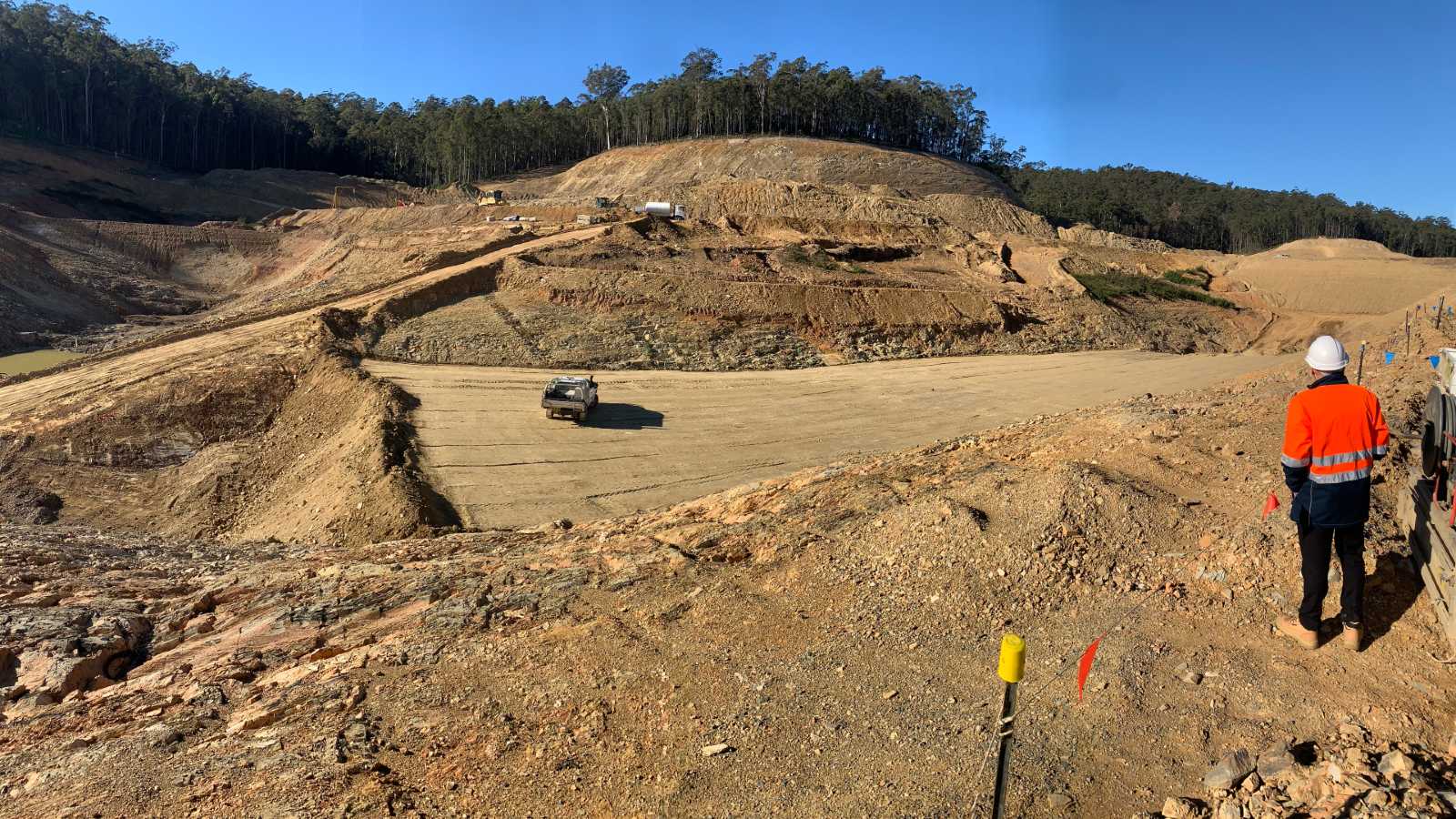
- We continued working on the foundation for the dam wall, finishing the base in May.
- Several rain events have slowed progress and we now expect work will continue into 2025. Even relatively minor rainfalls have caused significant delays as we focus on restoring the site and implementing stormwater treatment procedures before releasing water back into the environment.
2023
- The contractor built a temporary coffer dam which helps channel water away from the main dam during construction.
- Vegetation clearing works continued.
- We started working on the outlet pipe, the outlet tower and the tower bridge.
- We worked on the dam's foundations, a spillway and a boat ramp.
- We started processing and stockpiling material to build the dam embankment.
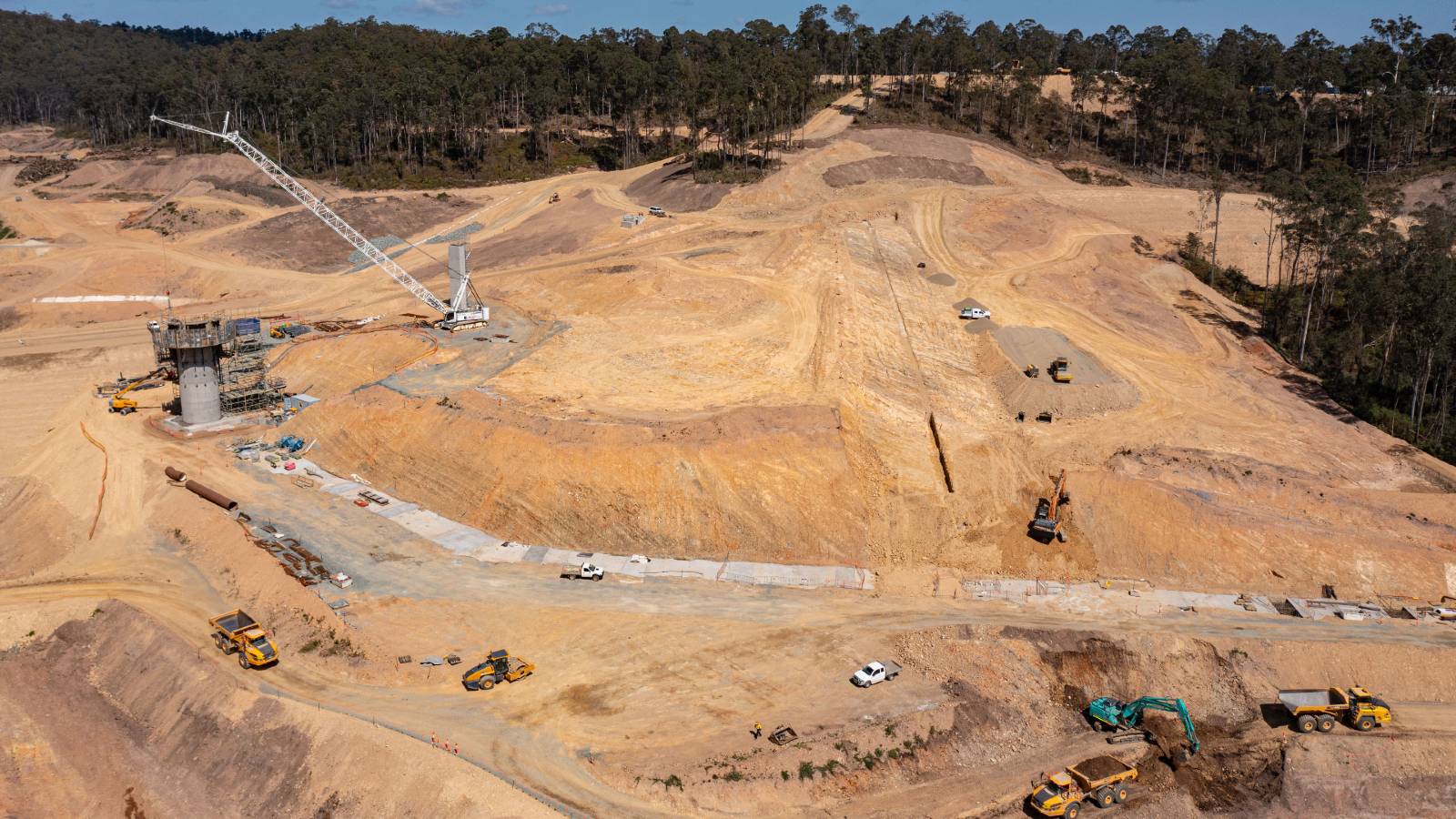
- We created a barrier to limit the amount of water seeping through the dam's base.
- Our plan is to finish this foundational work by early 2024, so we can then start building the actual dam wall.
2022
- Our construction crew built an access road off Eurobodalla Road.
- Preliminary works began on the dam site to minimise the environmental impact. Work included an ecological survey, weed control and nesting box installation. At all stages of works, we are taking steps to ensure positive environmental outcomes.
- Forestry Corporation harvested timber from the dam site. Small trees, groundcovers and tree stumps were left intact where possible to help with site stability until the dam is built. An ecologist supervised removal of all hollow bearing trees to minimise harm to native fauna.
- We awarded the tender for the dam construction to Haslin Constructions who arrived on site in September and began:
- preparing the Dam Access Road to cater for heavy vehicles and plant
- clearing the remaining vegetation on the dam site
- building the outlet tower base.
2021
- Work on the Tuross River Pump Station began in February. Quay Civil undertook excavation works followed by restoration of the riverbank. The contractor began constructing the pump station tank in September.
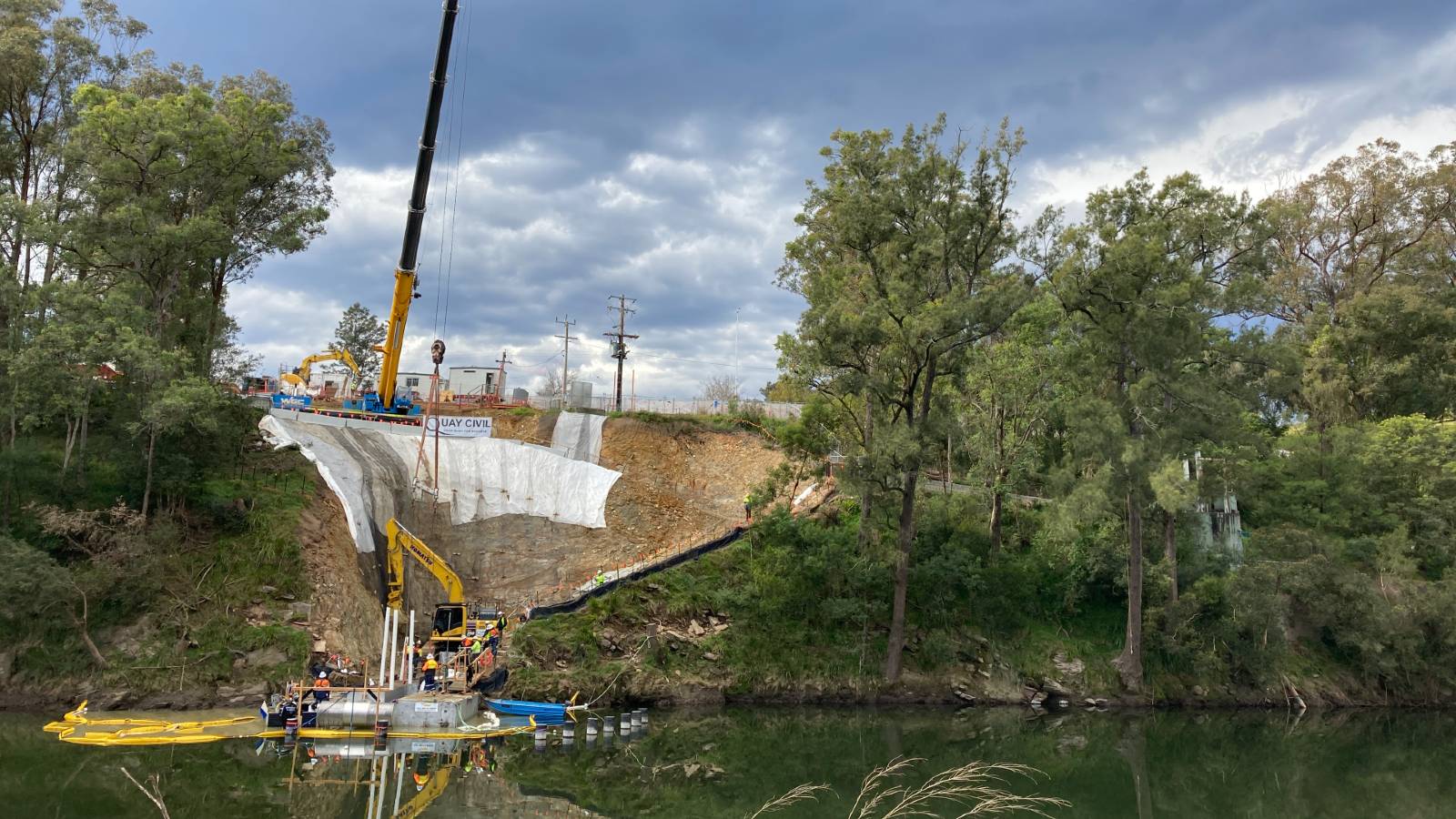
- The Federal Government came to the party with $51.2 million in May allowing us to make this project happen. Read about the funding announcement in our May 2021 media release.
- We called for expressions of interest for tendering of the dam construction contract. We finalised a shortlist of tenderers and we expect to award the tender mid-2022.
2020
- With some funds available we began work on the Tuross River Pump Station. We cleared the site and advertised the tender for construction.
- We awarded the pump station construction contract to Quay Civil.
2019
- We liaised with a local property owner and the Forestry Commission to buy the land needed for the dam, pump station and access roads.
- We applied to the NSW Government for funding under the Safe and Secure Water Program. The NSW Government applied for funding under the National Water Infrastructure Development Fund.
- The NSW Government announced $25.6 million to help fund the project. The commitment allowed us to buy the land and construct the pump station.
- The water storage facility design was completed and reviewed by a qualified dam engineer. The documents were provided to the NSW Dams Safety Committee.
- The NSW Department of Planning and Environment provided project approval.
2018
- Council introduced water restrictions highlighting the need for the Southern Water Supply Storage.
- Detailed design work was undertaken on the proposed Southern Water Supply Storage.
- The concept designs for the project were placed on public exhibition. We considered the feedback to further refine options.
- The EIS was completed and placed on Public Exhibition from 7 September until 18 October.
- We hosted an information session and encouraged the community to review the EIS.
- NSW Planning and Environment reviewed the submissions.
2017
- Flora, fauna and heritage studies were undertaken. The field work allowed work to begin on the draft EIS.
- Specialists did geotechnical investigations to help with the design of the storage facility.
2016
- Council engaged SMEC to prepare the concept design, detailed design and EIS.
- Field investigations began for the EIS.
Contact us
For further details about the project, please contact our Water & Sewer Project Engineer, Harvey Lane:
- T: 02 4474 1342
- E: Harvey Lane
You can provide feedback on the project using our online feedback form.

